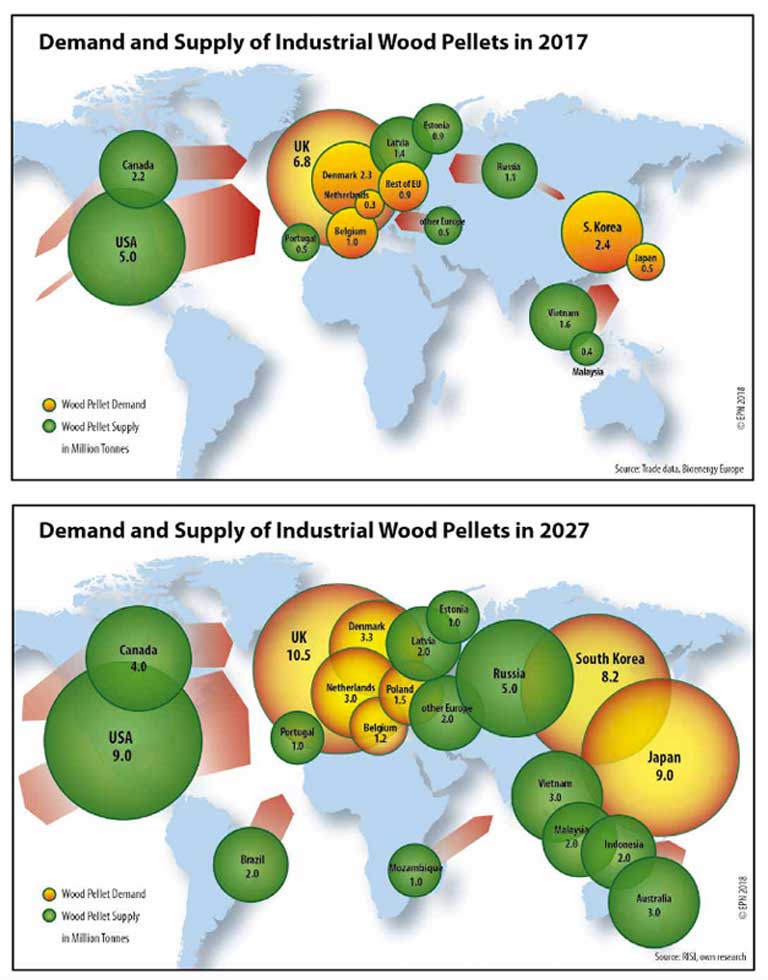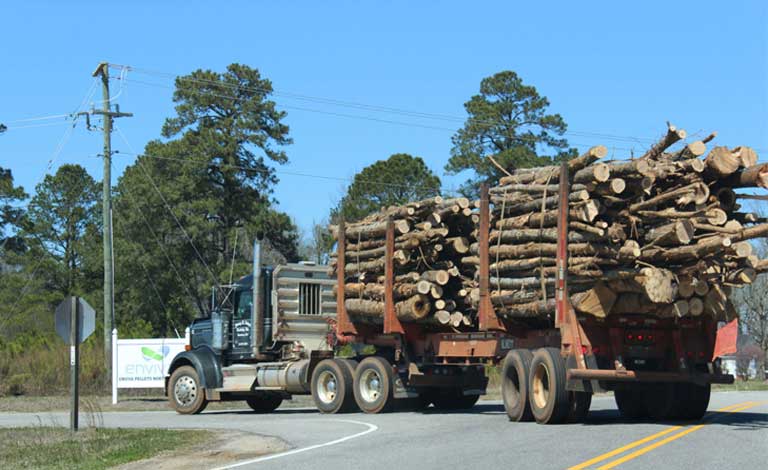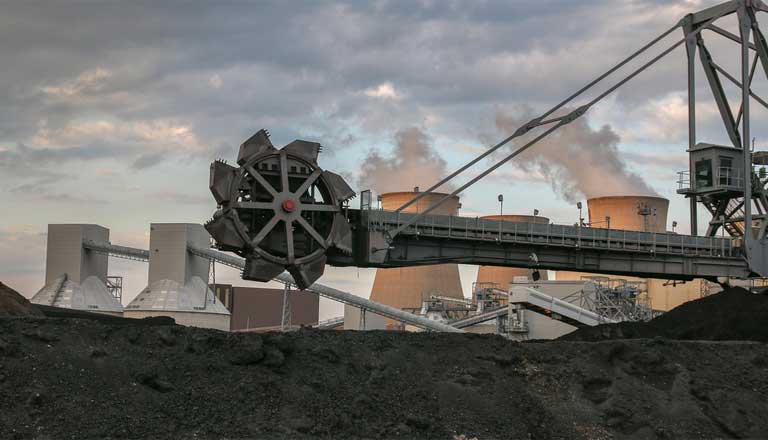Why the boom in biomass electricity needs to stop urgently

The forest biomass industry is sprawling and spreading globally — rapidly growing in size, scale, revenue, and political influence — even as forest ecologists and climatologists warn that the industry is putting the planet’s temperate and tropical forests at risk, and aggressively lobbying governments against using wood pellets as a “renewable energy” alternative to burning coal. (Click here for an interactive map of the hundreds of major bioenergy burning power plants now operating worldwide.)
“We have repeatedly pointed out that… the large-scale substitution of coal by forest biomass [to produce electricity] will accelerate climate warming, and will increase the risks of overshooting Paris [Climate Agreement] targets,” Michael Norton, environmental director of the Science Advisory Council of the European Academies, said in a December 2019 statement issued to European Union countries.
“The reason is simple: when the forest is harvested and used for bioenergy, all the carbon in the biomass enters the atmosphere very quickly, but it will not be reabsorbed by new trees for decades. This is not compatible with the need to tackle the climate crisis urgently,” said Norton.
As the forest biomass industry expands rapidly in the U.S., Canada, Russia, Vietnam and Eastern Europe, so too does the threat to untold acres of natural forests and their biodiverse ecosystems needed for carbon sequestration and climate change mitigation in those same nations and regions, even as global warming is poised to set punishing new records in 2020.
“Our two biggest global environmental challenges — climate change and biodiversity loss — are inextricably linked, so keeping forests standing must be a priority of all governments,” said Natural Resource Defense Council Senior Advocate Sasha Stashwick, in an interview with BioEnergy Insight.
“Much of the wood burned in UK power plants is cut down and shipped from ecologically sensitive forests in the U.S. Southeast. Those forests are efficient and powerful carbon-capture systems and support unique wildlife found nowhere else in the world,” said Stashwick. But they can’t serve that important purpose if the trees are cut and turned into wood pellets, and don’t grow back for decades.

Biomass industry in full boom
With one possible exception in the Netherlands — where wood pellet burning is under examination as policy — today’s forest biomass industry is both refuting and shrugging off its environmental critics, and appears to be on a roll. That’s largely thanks to the so-called United Nations carbon accounting loophole that designates the burning of forests to generate electricity as carbon-neutral, despite recent hard science that shows otherwise.
Consider these news items, most published in just the past few months, sampling the industry’s explosive growth:
- U.S. wood pellet exports have more than tripled, from 1.9 million metric tons in 2012 to about 6.9 million metric tons in 2019; the first five months of 2020 outpaced the first five months of last year, according to Forisk Consulting, which analyzes the industry.
- Pellet maker Pinnacle Renewable Energy had a record second quarter (April-June 2020) for production and sales of forest biomass from British Columbia and Alberta, Canada. The company sold 620,000 metric tons of wood pellets for export during the three-month period, up 21% over the previous quarter, and up 30% when compared to the second quarter of 2019, according to public filings.
- Maryland-based Enviva, publicly traded and the world’s largest producer of industrial-use wood pellets, spent $175 million to purchase its ninth plant in the U.S. Southeast. Two more plants are under construction in Alabama and Mississippi and promise to be the largest pellet-producing facilities on earth. Eniva’s pellets are bound for burning at converted coal plants mostly in the UK, but increasingly Japan and South Korea.
- North Carolina, the largest pellet-producing state in the U.S. Southeast, just approved its fifth plant, this one in Robeson County, which already has a large Enviva plant; all pellets are exported. Despite opposition from the public and environmental groups, the NC Department of Environmental Quality (DEQ) issued a permit to UK-based Active Renewable Energy Power, even as DEQ pledges to never use biomass to make energy for North Carolina.


- UK-based Drax, the world’s largest user of wood pellets for energy production, has had a booming first half of 2020. It reported a win-win for investors with biomass energy generation up 16% over the first half of 2019. Also, production at its own pellet-making plants in the U.S. Southeast is up 15% over 2019, with costs down 9%. Drax continues to enjoy more than $1 billion annually in government subsidies because biomass is technically deemed a carbon-neutral energy source on par with wind and solar.
- Subsidies for biomass energy generation are so great in South Korea that — as in the UK and EU — the Asian nation is reducing investments that would otherwise go to truly renewable energy sources like wind and solar, according to a new study. Russia and the U.S. are supplying South Korea with pellets, but so too is Vietnam, Indonesia and Malaysia, whose biodiverse rainforests are already under extreme pressure from agribusiness and mining.
- Japan, the world’s third-largest economy, must import nearly all its energy since the Fukishima nuclear disaster in 2011. To meet that need, it is converting more than 20 coal-fired power plants to co-fire with wood pellets and coal until a complete transition to pellets can be made. Vietnam, relatively new to pellet production, will likely clear cut thousands of acres of rainforest to meet Japan’s surging biomass demand. Pellet makers in Canada and the U.S. are also gearing up to meet Japan’s soaring demand.
- According to financial forecasters, global revenue for solid biomass is projected to nearly double from $221.7 billion in 2019, to $425.8 billion by 2027. Much of those profits will come from harvesting and burning trees — along with the spewing of carbon into the atmosphere, while meeting Paris Agreement national carbon targets on paper.


Biomass defense and carbon loophole
Forest experts have argued for a decade that the biomass industry is the beneficiary of a flaw in the 1997 Kyoto Protocol that classified forest biomass burning as a renewable energy source equivalent to zero-carbon wind and solar.[/caption]
The reasoning then was that the carbon released by burning wood pellets would be offset by the replanting of new trees — partly true, but with a huge caveat. Studies have shown that carbon neutrality, if enough new trees are planted to replace those pelletized, takes 50-100 years — a timeframe far too long given the accelerating pace of climate change. The UN itself says we have just ten years to make drastic emissions cuts or face catastrophic global warming impacts.
But today, with the UN’s full blessing, countries continue burning forest biomass without needing to count the actual carbon emissions produced against their Paris Agreement carbon reduction pledges, thus giving a false, on-paper-only accounting of reductions. Studies have shown that biomass actually pollutes more than coal because more biomass is needed using wood pellets to generate the same amount of energy as coal.
The biomass industry argues that its critics have it all wrong. In public hearings, statements and scientific reports of their own, the industry stresses that it is a green climate-friendly alternative to burning coal. The companies argue, for example, that they do not clear cut forests, but rather “manage” harvests in such a way that carbon sequestration is undisturbed, even as forest advocates tracking those same harvesting methods tell a far different story.
“While our industry welcomes robust scrutiny and debate on the issues,” said Seth Ginther, executive director of the U.S. Industrial Pellet Association, in a statement, “it’s important for us to recognize and acknowledge that we have reached a tipping point where the overwhelming data, evidence and peer reviewed research points to the fact that sustainable biomass is part of the climate change solution.”
With EU countries required by law to reduce their carbon emissions annually, Ginther’s pro-biomass advocacy position appears to hold sway — not the contrary view held by forest ecologists and environmentalists. Nearly 60% of renewable energy generated in the EU today comes not from wind or solar, but from burning biomass, mostly using wood pellets made out of whole trees and lumber waste.
Pushback in the Netherlands
In early July, environmentalists met with some success In their advocacy against biomass. The independent Dutch Social Economic Council (SER), made up of business leaders, academics and NGOs, recommended to the Dutch Parliament that it phase out the use of biomass for electricity and heat generation. The Netherlands gets 61% of its renewable energy from biomass.
SER recommended that biomass still be used, though in smaller quantities for the production of innovative chemicals, bio-plastics and bio-concrete, instead of using fossil fuels for those limited purposes. The Dutch government will decide this fall how, or if, to incorporate these recommendations into its climate change mitigations laws. Those laws call for carbon emission reductions of 49% by 2030.
Almuth Ernsting, with Biofuels Watch in Scotland, has been lobbying against biomass in the EU for 10 years. She called the SER solution an imperfect compromise, but told Mongabay, “If the Dutch government accepts the recommendations and implements them, that would send a really strong signal to other EU nations [on biomass]. The Netherlands is one of the big players within the EU and internationally. If [the SER report] gets translated into meaningful policy change, it will make a huge difference.”
That difference could save forests in Eastern Europe, according to Martin Luiga of Forest Aid Estonia: “Logging rates in Estonia are far too high to protect the climate. Most of our endangered species are forest-dwelling species, and there is widespread public concern about the intensity of logging. Nonetheless, the prevailing political mood is to further increase the harvesting volumes. Reducing demand for pellets would greatly help the situation and thereby protect Estonian forests.”
A RED review?
Rita Frost, campaigns director with the North Carolina, USA-based Dogwood Alliance, a forest-protection NGO, has likewise focused her efforts on shifting the Netherlands position on biomass. That includes targeting the EU’s Renewable Energy Directive (RED), which states that burning wood pellets is carbon neutral and a legitimate way to reduce carbon emissions.
“It goes back to the problem with the RED and the belief that there is [such a thing as] sustainable biomass,” Frost told Mongabay. “The industry has used that argument effectively in Sweden, Finland and the Netherlands, which have intensive forestry management practices. And when [those governments] look at the [wood pellet] supply coming from the U.S., they figure it must be okay. But with our work, and the work in the Baltic states, the picture is much different on the ground, where we have documented the extensive loss of forests.”
Environmental advocates have won some smaller victories in the past few years — prevailing on the UK to cap subsidies and expansion of its massive Drax pellet burning plant, while also seeing the EU put some new biomass plants on hold.
Also, as a matter of UK policy, subsidies to Drax for burning biomass, having started in 2007, are now set to end in 2027 unless the company successfully lobbies for an extension. Fourteen EU countries presently provide subsidies for bioenergy, but it’s unclear how long such taxpayer support will remain in place, according to research by the Natural Resources Defense Council (NRDC), an NGO.


Ultimately, biomass critics acknowledge that real change depends on the EU revising its Renewable Energy Directive (RED) and closing the carbon neutrality loophole. At the UN climate summit in Madrid last December, Franz Timmermans, executive vice president of the EU and a Dutch politician, told Mongabay that RED’s current biomass position needed to be reviewed because of recent scientific studies, perhaps in 2021.
“The issue of biofuels needs to be looked at very carefully,” Timmermans said in Madrid. “We have to make sure that what we do with biofuels is sustainable and does not do more harm than that it does good.”
Almuth with BioFuels Watch said she was encouraged by Timmermans’ comment, but stressed that much more work on the part of scientists and environmentalists is needed to shift public opinion and create political will in the face of a biomass industry steadily growing larger, wealthier and more influential.
“Any legal change to the RED would require the support of the majority of [EU] member states, or 15 or 27 countries,” Almuth said. “It will take a lot of awareness raising and campaigning to make that possible. That’s why the upcoming debate and political arguments coming this fall in the Netherlands over biomass and carbon neutrality is so important.
This article first appeared on Mongabay on 31st August 2020.
Related Posts


